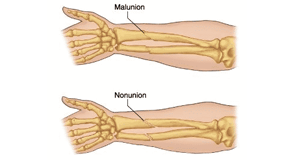Malunions
A malunion occurs when a fractured bone heals in an abnormal position, which can lead to impaired function of the bone or limb and make it look like it is ‘bent’. Similarly, a nonunion is the result of a fractured bone failing to heal after an extended period of time – in some cases over a period of 9 to 12 months.
“Malunion” is a clinical term used to indicate that a fracture has healed, but that it has healed in less than an optimal position. This can happen in almost any bone after fracture and occurs for several reasons.

It may result in a bone being shorter than normal, twisted or rotated in a bad position, or bent. Many times all of these deformities are present in the same malunion.
Some times Malunions can also occur in areas where a fracture has displaced the surface of the joint. When this happens, the cartilage in the joint is no longer smooth. This may cause pain, joint degeneration, “post-traumatic arthritis” or catching or “giving-way” episodes resulting from instability or incongruency of the joint.
The symptoms of a fracture malunion include:
- Swelling
- Pain
- Tenderness
- Deformity
- Difficulty bearing weight
Treatment
Orthopedic Surgeon at Shreya Hospital have vast experience in treating malunion. In almost all situations, treatment involves cutting the bone, at or near the site of the original fracture. The cut or “osteotomy” is done to correct the mal-alignment. In addition, some secure method of fixation must be used to hold the bones in the desired position. This fixation may require plates, rods, or an external frame with pins.
Malunions that include shortening of the bone often require some method for bone lengthening.
Malunion and nonunion fractures are fundamentally different than the original fracture, and diagnosing the cause of the malunion or nonunion is important to creating the best treatment plan.
There are four main factors that Orthopaedic Surgeons at Shreya Hospital look for before completely treating a malunion or nonunion fracture. They include:
Infection responsible for Malunion
Malunions and nonunions caused by infection are among the most challenging to treat.
We will perform blood tests to determine if there is any infection lingering. If necessary, a local biopsy may be performed, as this will provide a much more reliable answer.
The infection must be eliminated before any reconstruction can occur.. This is a multistep process involving a round of antibiotics, debridement of all affected bone and soft tissue, any needed wound closure and removal of external fixation. This may also include removing any and all hardware that a patient might have, to remove any bacteria that could be adhered to metal and protected from antibiotics.
After the infection is treated, reconstruction can begin. At Shreya Hospital, our limb salvage experts take the extra mile in preventing additional infection by applying local antibiotics to the fracture site. Orthopaedic Surgeons mix bone cement with antibiotic and create a necklace of antibiotic beads which is then placed in the site. This is done to further prevent a recurrence of infection. Once infection is cleared, reconstruction of the limb can be initiated using necessary orthopaedic and orthoplastic techniques and technology.
Adequacy of blood supply
Having an adequate blood supply helps in healing a fractured limb. If Orthopaedic surgeons suspect inadequate blood supply in the bone, they will perform a CT scan or SPECT scan to confirm suspicion of dead bone.
If this is the case, the dead bone must be removed to access healthy bone and bring the ends of the living bones together. Vascularized or non-vascularized bone grafts can also be used to bridge the gap.
Depending on the amount of affected bone that must be removed, this may result in a disproportion in length. This difference in length can be addressed with advanced limb lengthening procedures.
Biomechanics responsible for Malunion
Fractures complicate many things and impair movement. For fractures to heal properly, they need appropriate stability. Stability issues fall into two categories: hypertrophic and atrophic. Hypertrophic malunion or nonunion fractures are typically the result of inadequate fracture stability (either too little or too much support) but have strong healing potential. Atrophic malunion or nonunion fractures often have a more complicated, multifactor cause and require more complex treatment.
Orthopaedic Surgeons evaluate musculoskeletal structure including alignment, healing, and the hardware used to identify type and how to address the stability issue which is dictated by location, which bone is affected, and what type of malunion has occurred.
For fractures that require dynamic stabilization like fractures of the lower thigh bone or those around other major joints, Shreya Hospital uses state-of-the-art flexible screws and plates that allow for movement – providing the relative stability required for the bone to optimally heal.
Biology
A person’s biology is also an important factor for healing. As part of diagnosing complex fractures, the medical staff will perform lab tests to check thyroid levels, vitamin D, calcium, magnesium, and phosphorus levels–to name a few. Knowing these levels help physicians and surgeons understand how capable the body is to facilitate healing on its own. If there are any hormonal imbalances, specialists such as an endocrinologist will treat you before reconstruction can occur.
With these factors and their unique treatments addressed, the Shreya Hospital team is able to surgically correct the fracture using tailored options and procedures including new approaches and technology being developed at Shreya Hospital.
 Dr. Mishra’s Shahdara Orthopaedic Center Shahdara Orthopaedic Center, Best Orthopaedic Doctor in Shahdara, Delhi
Dr. Mishra’s Shahdara Orthopaedic Center Shahdara Orthopaedic Center, Best Orthopaedic Doctor in Shahdara, Delhi
